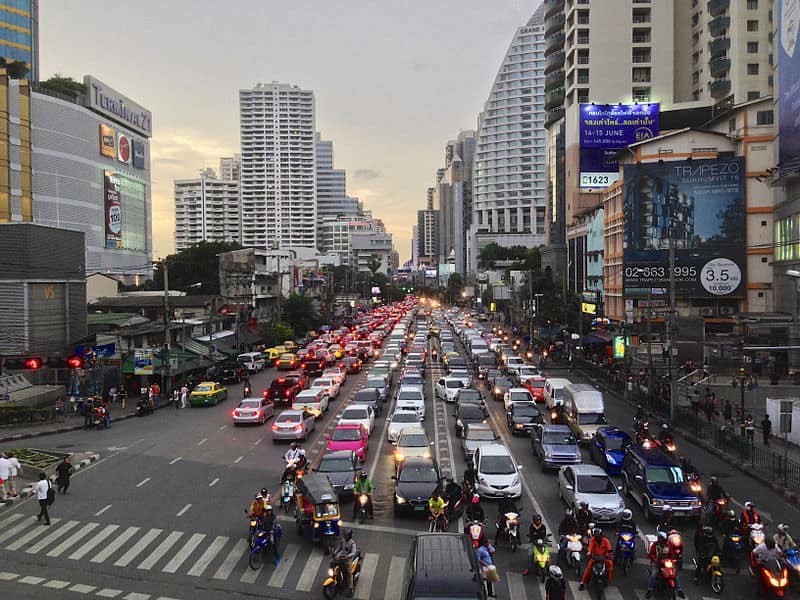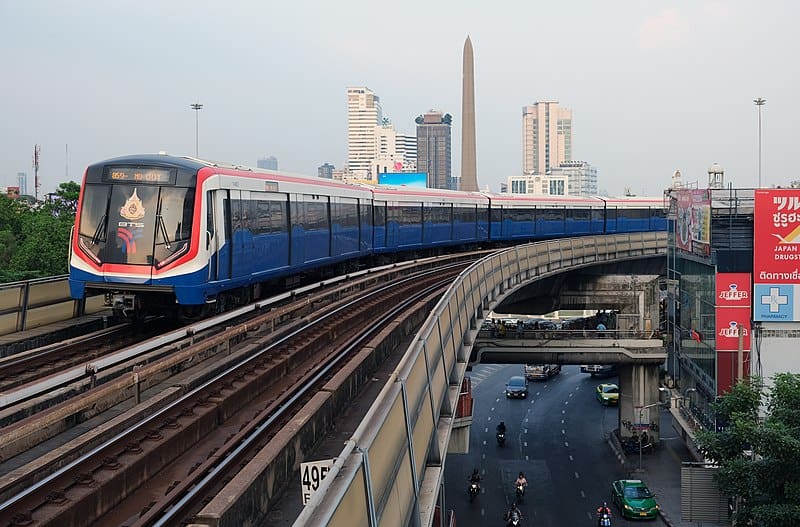Top Ten Historical Facts about Bangkok
The capital city of Thailand has played a crucial part in the history of the country.
Bangkok today is a bustling, expanding, crowded city, known for its spectacular Buddhist temples, royal palaces and canals. It is a sprawling, chaotic, heavily-contrasting metropolis of temples, factories, shops, and homes along roads, canals, and all kinds of other complexes imaginable.
Bangkok, or in Thai ‘Krung Thep’, is the chief port of Thailand and is still in many ways the only city in a country of small towns and villages that comes anywhere close to being cosmopolitan. It also serves as Thailand’s cultural and commercial centre, and has long been the modern central political stage, with protests and ensuing coups d’état having taken place on its streets throughout the years.
Although Bangkok was originally based around a system of canal networks, many of the former waterways have slowly disappeared, and due to the last 50 years or so of growth and development, Bangkok has at times come close to being considered one of South-East Asia’s most dynamic cities.
Although founded only two hundred years ago, it still has a colourfully historic district known as the Rattanakosin Isle, with plenty of old culture, and in many ways Bangkok is much more historical than some might imagine.
The exact history of Bangkok is not black and white but goes some way back to the 14th/15th century when there were small trading and farming settlements lining the banks of the Chao Phraya River, (apparently known as Bang Makok).
At that time, the region was ruled by the great Ayutthaya (Ayuddhaya) dynasty, centred in the city of the same name.
The region that is now Bangkok proper gradually increased in prominence, and following the fall of Ayutthaya-period king Taksin, who had established his new capital in Thonburi on the west bank of the river, King Phutthayotfa Chulalok, his successor to the throne, relocated to the eastern bank in the late 1700s—our first of Top Ten Historical Facts about Bangkok.
And as there are so many ‘Ten Amazing Facts’ blogs out there now (which clearly have not been fact-checked), we’ve tried to include more actual, historical, checkable information here with the top ten historical facts about Bangkok.
Bangkok became the capital in 1782
Bangkok became officially recognised as the capital in 1782, when General Chao Phraya Chakkri (who was the founder of the ruling Chakkri dynasty), assumed the throne as Rama I after the deposition of King Taksin.
It was Rama I who moved the court from the west to the east bank of the Chao Phraya River.
The modern city was established before the end of the king’s reign, and many structures and buildings in the city today such as the walled Grand Palace complex and the temple Wat Pho were completed at this time. There was also a new city wall, an imposing structure, which ran along the river.
Bangkok was originally modelled on Ayutthaya
Rama I modelled the new city on the previous capital, Ayutthaya. This is most evident from the The Grand Palace (complete with Government offices), The Front Palace and the Royal Temples by the river, next to the royal field (which is now Sanam Luang).
Moving outwards from this complex the royal court of justice, royal stables and military prison were constructed. In traditional fashion, residences of royalty and nobles were located south of the palace walls, with further settlements spiralling outwards.
The new capital was referred to in local circles as Rattanakosin, which is a name shared by the Thai royalty of this era.
Eventually though, the name Krung Thep and Krung Thep Maha Nakhon, both shortened forms of the full ceremonial name, came into use late 19th century. Apparently it was foreigners who continued to refer to the city by the name Bangkok, which is obviously still used today.
Bangkok was once divided in two
Following on from storyline of the two Ayutthaya-era kings who both established capitals on the east and west banks of the river, this situation continued to affect things in Bangkok for quite some time to come.
So the city was formerly divided into two municipalities—‘Krung Thep’ on the east bank and Thon Buri (the first site) on the west, connected by a few bridges.
It wasn’t until 1971 when the two were joined together as a city-province with a single municipal government, and by 1972 the city and the two surrounding provinces had been united into one province, called Krung Thep Maha Nakhon (Bangkok Metropolis).
Bangkok was modernised by King Chulalongkorn (Rama V)
It was the Thai king Chulalongkorn (1868–1910) who was set upon the modernisation of the country. He introduced a wide range of reforms, and adopted the Western concept of nationhood.
Throughout the king’s reign many more canals and roads continued to be built, the infrastructure was developed, and electricity was introduced — first in government offices, and then later for the general public. The King had a deep interest in West which was further reflected in the adoption of Western-style dress, and also in much of the architecture used in the ensuing development.
Bangkok has had a constitutional monarchy since 1932
Thailand was ruled by an absolute monarchy until a coup d’état (one of a seemingly never-ending succession) in 1932.
This particular takeover was launched by the Khana Ratsadon (“Peoples’ Party”), the first political party in Siam, led by a small group of civilians and military.
The coup overthrew the government of King Prajadhipok of the Rattanakosin Kingdom, which ended around 800 years of absolute monarchy under the Kings of Siam. The important historical events of this time saw the transition of Siam into a constitutional monarchy system of government, with the first introduction of attempted democracy and the first constitution of Thailand.
This event was also considered by many to herald the start of the civilian-military rivalry for control of the Government of Thailand that has caused political instability in modern Thailand and remains one of the country’s key issues.
The B.M.A. (Bangkok Government) was formed 45 years ago
The Bangkok Metropolitan Administration (BMA) is the system of governance used in Bangkok, since it was formed 1975.
The B.M.A. is basically the local government of Bangkok, and is composed of two main branches, which include the executive (Governor of Bangkok) and the legislative (Bangkok Metropolitan Council).
The role of the administration is to manage Bangkok in terms of transport services, urban planning, waste management, housing, roads and highways, security services, and the environment.
Bangkok was bombed by The Allied Forces during the war
Bangkok was actually bombed by the Allies on several occasions throughout World War II. The main reason for this was not the Thais though, it was the Japanese.
The Japanese were using some areas of Thailand to launch invasions of both Malaysia and Burma. This was reluctantly agreed to by the Thai government following a successful Japanese invasion on 8 December 1941.
The first Allied attack was on 7 January 1942, when British Royal Air Force (RAF) aircraft coming from Rangoon, bombed designated targets in Bangkok.
The subsequent bombings of both the British and the US forces targeted installations used by the occupying Japanese military, and were also aimed at pressurising the military Thai government to relinquish its unpopular alliance with the imperialistic Japanese. The major targets were the newly completed Bangkok Port and the Thai railway system.
A few other ensuing raids by B-29s had limited degrees of success regarding intended targets. Some managed to level a Japanese military hospital and damage the Japanese secret police headquarters, before the Allies decided to turn their attention instead to the home territories of the invading Japanese.
Transportation systems in the city were originally water-based
Bangkok’s transportation system was originally based around water travel, and in particular canals.
Originally known as the ‘Venice of the East’ the maze of canals connected with the river earned it the name, and transportation (along with commerce) via some form of boat was the main means at that time..
Drastic changes began to occur with the appearance of cars. The number of vehicles in the city increased faster than expected, and soon there didn’t seem to be enough road space. Most of the smaller and a number of the larger canals were filled in first to facilitate the laying of roads.
This proved not to be (and continues to prove not to be) the wisest move, as the waterway system had served to drain the waterlogged delta. After this point (as more and more canals were filled in and built upon), flooding of the lower-lying parts of the city thus became increasingly frequent, and this remains one of the main issues today.
Bangkok has had a Skytrain for two decades
In direct contrast to the canal system waterways and the ever-congested roads that were built over them, eventually came the more modern mass rapid transportation systems of both the BTS Skytrain and the MRT Subway systems in Bangkok.
The BTS Skytrain was actually the first mass transport system developed and launched in a bid to combat the escalating traffic congestion problems in the city, with the underground system being completed in its first stages 5 years later.
The supplier of the railway technology was Siemens, and the system was constructed by the Thai contractor, Italian Thai Development. The “Skytrain” name came via the press by way of comparison after a similar example that already existed in Canada’s Vancouver had been named “Skytrain”.
The Skytrain system was officially opened in December 1999, and for a while had a much lower-than-expected usage of around 200,000 passenger trips per day. Ticket revenue at that time apparently only just met the operating costs, although the Skytrain’s daily volumes of passengers have been steadily increasing since then.
The initially-planned BTS Skytrain depot was meant to be built underneath Lumphini Park, but this idea was shelved due to objections from Bangkok residents, and in particular those of the surrounding area. It was then built instead on a stretch of land on Phahonyothin Road, where the old northern/northeastern bus terminal (Mo Chit) was formerly situated.
This depot at Mo Chit now forms part of a proposed “Bangkok Terminal” project, which is an intended large complex comprising a new regional bus terminal and a park and ride facility.
By 2005, the volume of daily users was recorded at more than 500,000, and this figure had further increased by another 100,000 by 2012. These days the average is around
The BTS presently has a fleet of 52 four-car trains, a total of 208 carriages. And to put the current demand into perspective, there are almost 50 new four-car trains, almost a further 200 carriages, on order. These will aim to address the ever-expanding capacity requirements of the existing lines, and also take into consideration the full launch of Northern and Southern Green Line extensions which are ongoing.
Bangkok has had a subway for almost 20 years
The Metropolitan Rapid Transit (MRT) is an underground mass rapid transit system running under the streets of the Bangkok Metropolitan Region in Thailand.
The MRT system was opened in 2004, and is comprised of two main rail lines, and is expanding outwardly quite rapidly in order to cover a wider area. A further three lines (including one rail line and two monorail lines) are currently under construction, and these are due to open in 2021.
The MRT Blue Line (officially the Chaloem Ratchamongkhon Line) runs between Hua Lamphong and Bang Sue, and was the first to open as part of Bangkok’s second major metro system.
The MRT Purple Line (officially the Chalong Ratchadham Line), was launched more than a decade after the first line, on 6 August 2016. This line connects to northwestern regions of Greater Bangkok namely between Tao Poon and Khlong Bang Phai in Nonthaburi.
The MRT forms part of Bangkok’s rail transportation infrastructure along with the BTS Skytrain System and the Airport Rail Link. The two current Mass Rapid Transit lines service almost as many as 500,000 passengers each day, and operate 45 stations which comprise a total combined route length of 60-odd kilometres.
Planning a trip to Paris ? Get ready !
These are Amazon’s best-selling travel products that you may need for coming to Paris.
Bookstore
- The best travel book : Rick Steves – Paris 2023 – Learn more here
- Fodor’s Paris 2024 – Learn more here
Travel Gear
- Venture Pal Lightweight Backpack – Learn more here
- Samsonite Winfield 2 28″ Luggage – Learn more here
- Swig Savvy’s Stainless Steel Insulated Water Bottle – Learn more here
Check Amazon’s best-seller list for the most popular travel accessories. We sometimes read this list just to find out what new travel products people are buying.




















